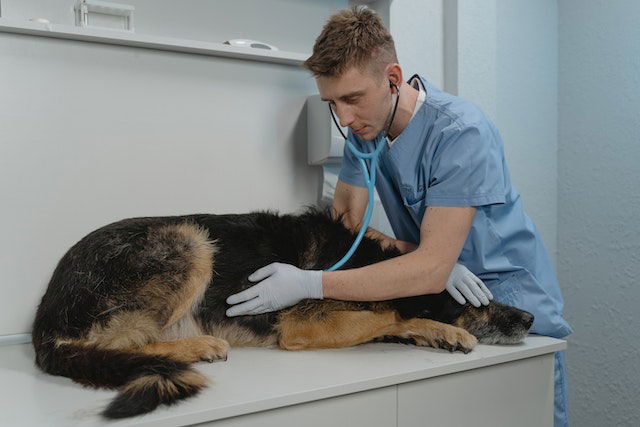We're an affiliate
We hope you love the products we recommend! Just so you know, we may collect a share of sales or other compensation from the links on this page at no additional cost to you. Thank you if you use our links, we really appreciate it!
Have you ever gone for an evening stroll with Fido and saw him walking sideways? Sidewinding, as it is commonly called, occurs when dogs appear to walk sideways in a ‘c’ shape.
As a caring pet parent, you may be concerned by your dog’s strange walking behavior especially when it is all of a sudden.
Crab walking in dogs can be attributed to several reasons, and for the most part, the condition is temporary unless for severe injuries or illnesses.
Sometimes this behavior may be a sign of imbalance and poor coordination, that’s why it’s always a good idea to check with your vet to rule out health problems.
Knowing the possible reasons why your dog walks sideways is helpful to guide you in the specific remedy action you will take.
This post contains the details you need to know about this behavior including the possible reasons, and how you can help your dog get back to normal.
How Dogs Should Walk
Before we look at sidewalking behavior in dogs, we need to understand how dogs should walk in an ideal situation.
The normal dog gait patterns are; walk, amble (faster walk), pace, trot, lope(canter), and running (galloping).
Walking is the slowest gait pattern in dogs and it involves the dog lifting each foot one at a time in a particular sequence.

Walking is the only gait where the dog has 3 feet on the ground at any time to support the body and to maintain balance in a steady movement.
The proper functioning of the musculoskeletal system and the central nervous system plays a crucial role in enabling dogs to walk normally.
These two systems work in harmony to provide the dog with balance and coordination when standing still and walking.
Why is My Dog Walking Sideways – Medical Causes
It is indeed possible that your dog may alter their normal gait pattern because of an underlying medical problem. Some of the health concerns to worry about include the following:
1. Vestibular Syndrome
The vestibular system in dogs is made up of the central sensing components in the brain and inner ear that control normal balance, posture, and spatial orientation. This helps to keep the dog in place and prevent them from falling.
For dogs to maintain normal balance, they need to make very small changes in the orientation and movement of the whole body including the eyes.
In case of a dysfunction of the vestibular system in dogs, they may end up losing their balance and walk in a ‘C’ shape.
The other symptoms of vestibular diseases in dogs include loss of coordination, tilting the head, general wobbliness, drooling, vomiting, rapid eye movement, and walking in circles.
Vestibular diseases in dogs can be caused by ear infections (otitis), ear tumors/polyps, injuries from road accidents, or a bad fall from elevated surfaces.
Some types of canine medication such as aminoglycoside antibiotics may cause vestibular disease in very isolated cases.
Diagnosis of vestibular syndrome
Your vet will probably ask about your dog’s medical history before starting a physical checkup for other signs.
Make sure to list all the symptoms, illnesses, and your dog’s recent history of drug prescription for a proper diagnosis procedure.
The vet will proceed to carry out a physical examination for the signs of imbalance and poor coordination.
If your dog is suspected to have vestibular disease, the vet will do a neurological exam to check for ear tumors, brain tumors, or ear infections.
An advanced imaging technique like an X-ray may be used to confirm the presence of ear tumors or polyps.
The subsequent medical tests will depend on the findings of the neuro exam. Most dogs with suspected vestibular syndrome have undergone an ear cytology test, complete blood count, and urinalysis.
Treatment of Vestibular Disease in Dogs
Vestibular disease in dogs can be linked to various underlying problems such as nerve tumors, and ear infections.
Your vet will perform treatment procedures on the confirmed underlying medical problem to ease the symptoms.
Additionally, the vet will recommend supportive care for dealing with vestibular disease. Some of the medications commonly used include antibiotics, anti-nausea drugs, intravenous fluids, and ointment for skin care.
Early treatment of the underlying cause can make your dog get better with the application of appropriate treatment techniques.
Your affected dog may show little improvement if they had undergone irreversible damage to their coordination sensors.
2. Musculoskeletal Disorder in Dogs
The musculoskeletal system in dogs is made up of the muscles, bones, joints, ligaments, and tendons. This system works together to support the dog’s weight and normal body movement.
Sideway walking in dogs can be an indicator that their musculoskeletal system is not functioning properly.
The other signs of musculoskeletal disorder in dogs include lameness, lethargy, ataxia, joint swelling, pain, and stiffness.
Musculoskeletal disease in dogs can indicate a problem with the skeleton, joints, muscle disorders, neurological diseases, infections, vascular disorders, and metabolic diseases.
Example of musculoskeletal disorder in dogs; diagnosis, and treatment
Hip dysplasia
This is the deformity of the dog’s hip joints as they grow. Hip dysplasia is commonly a hereditary disease and it is affected by factors such as environment, diet, and growth rate.
Your vet will diagnose your dog for suspected hip dysplasia through a physical exam and an X-Ray to confirm the deformity of the hip joints.
Hip dysplasia in dogs can be managed with a special diet on the recommendation of your vet. You can also find several non-steroidal anti-inflammatory drugs (NSAIDs) for pain relief.
Your dog’s treatment plan will depend on their individual clinical signs and the extent of discomfort experienced.
Adding chondroitin and glucosamine-based supplements to your dog’s diet may help in strengthening their joints and improving function.
In severe cases, your vet may prescribe a surgical procedure to replace the hip joints.
ii. Glycogen Storage Disease
Glycogenosis, also known as Glycogen Storage Disease (GSD)is a genetic illness in dogs and it occurs due to the deficiency of the glucose-6-phosphatase enzyme, responsible for the production of Glucose.
Glycogenosis affects the dog’s muscles and liver. GSD is diagnosed in the laboratory through blood work, saliva tests, testing glucose levels, insulin production, and genetics testing.
Since glycogenosis has no single cure, short-term supportive treatments may be recommended. Your vet may prescribe a high-carbohydrate diet and offer a dextrose injection to relieve your dog’s illness.
iii. Canine Muscular Dystrophy
These are various conditions (over 30) that cause the dog’s muscles to break down and walk with a stiff gait.
The vet will diagnose Muscular dystrophy by carrying out a muscle biopsy. Additionally, they may conduct an electrical stimulation test, and an immunohistochemical staining test, to confirm the results.
Putting your dog on corticosteroid drugs may help them get better from this condition. Your vet may recommend surgery in severe cases, and work out a tailored supporting therapy for your dog.
iv. Canine osteochondrosis
These are various conditions that affect bone growth in dogs due to injury, abnormal growth, or malfunctioning of the growth palate.
These conditions can be identified by carrying out a complete physical assessment of the dog’s body.

Your vet will perform several X-rays on the affected areas to get a radiograph of the cartilage. A computed tomography (CT) scan may also help to confirm the findings.
Prescribing NSAID medicines may help your dog relieve the pain from this condition and reduce inflammation.
Most veterinarians would however recommend surgical procedures to deal with the pain and advance treatment.
3. Neurological Disorders
The Central Nervous System (CNS) in dogs is made up of a complex circuit of the brain, spinal cord, and the nerves between them.
Similar to humans, the nervous system is part of the dog’s control center responsible for thinking, movement, coordination, breathing, and metabolic regulations.
Your dog’s sidewalking habits can be a sign of neurological disorders. Other symptoms of nervous system disorders in dogs include:
- Disorientation
- Seizures and convulsions
- Drunken walk
- Tilting of the head
- Dragging hind limbs
- Circling while walking
- Rapid eye movements
- Ataxia
- Twitching
- Weakness
- Reduced mental capacity
Neurological disorders can range from physical problems (such as the inability to walk properly) to those that affect your dog’s intellect such as the ability to understand the world or follow basic commands.
Genetic factors mostly cause neurological disorders in dogs, and some breeds are more highly predisposed than others.
Certain types of cancers, tumors, and trauma can also cause problems in the central nervous system.
The common types of neurological disorders in dogs include:
- Seizures
- Epilepsy
- Intervertebral disc disease (IVDD)
- Cognitive dysfunction
- Wobbler syndrome
- Degenerative myelopathy
- Meningitis
- Encephalitis
- Encephalomyelitis
- Stroke
Diagnosis of Neurological Disorders in Dogs
While on an appointment at your vet’s office, you may be required to provide your dog’s medical history, past trauma, and their exposure to toxins.
Make sure to recount every episode of your dog’s experience with the symptoms of neurological problems.
It will help if you take a clear video of your dog when walking wobbly, during moments of seizures, or any other unusual activity.
Your vet will perform a complete physical assessment of your dog and proceed to carry out lab work. The dog’s blood may be tested for several conditions, and an X-ray radiograph of the CNS may be helpful for confirmation of specific issues.
The vet may collect a sample of the cerebrospinal fluid through the back of your pup’s neck to perform a spinal fluid analysis. This will shed some light on the possibilities of infections or cancer.
If your dog is highly suspected to have neurological disorders, your vet may recommend a veterinary neurologist for highly specialized services.
Treatment of Neurological Disorders in Dogs
The specific treatment will depend on the underlying neurological condition. If your dog is found to have seizures, your vet will prescribe anti-epileptic drugs for relief.
Dogs with spinal cord issues can be put on anti-inflammatory medication such as steroids to reduce inflammation.
Lifestyle modification is an important aspect of treating dogs with nervous system disorders. In severe cases, a vet neurologist may recommend a surgical procedure to treat certain neural conditions.
4. Physical Injuries and Trauma
Physical pain in the legs can cause your lovely pup to adopt an unusual walking style. It may be easy to spot an injury on your dog’s leg because of their reluctance to apply too much pressure on the injured limb.
However, dogs can be very good at hiding pain, and sometimes when they walk sideways it’s because the pain has become too much to mask.
Sidewinding in dogs can also be an attempt to move at an angle that offers the least amount of pressure on the affected leg.
Non-Medical Reasons
5. Irritation From the Collar or Harness
Is your dog moving sideways only when using a harness? Then this could be a problem related to the walking gear and not the dog.
An uncomfortable harness and collar can be irritating to the dog and prompt them to pull and walk in strange positions.

Your pup may try to walk at an angle as a way of relieving themselves from the irritation of unfitting harnesses.
To help your dog in this situation, make sure to look for accessories that are of the appropriate size for your beloved pup.
Furthermore, you should concentrate on the harnesses and collars made with high-quality padded material for your dog’s comfort during walks and runs.
6. Dominant hind leg
This may come as a surprise, but did you know that dogs have a dominant leg? Your furry friend may be walking alongside you in a C shape because their right paw or left paw is taking control.
Dogs with a dominant back leg can walk in a strange pattern and this should not raise serious concerns if it happens.
When a pup with dominant hind legs is running, their powerful back paws (right or left) will bounce off the ground with a stronger force and this would move the entire body sideways.
Sidestepping due to the dominant leg is more common in growing puppies, who may have not figured out how to walk properly.
Some adult dogs can pick up this odd walking behavior into adulthood and walk sideways like a crab despite having no medical condition.
Frequently Asked Questions
1. Can temporary balance issues cause a dog to walk sideways?
The short answer is Yes! Dogs with an issue with balance and coordination will definitely start walking sideways like a crab until the issue resolves.
2. Is sideways walking a sign of pain in dogs?
Sideways walking in dogs can be a sign of pain but it is not always the case. Dogs with a dominant hind foot may appear to walk sideways because of the imbalance in forces on the ground, and this is not a sign of pain.
However, injuries, medical conditions, and uncomfortable harnesses may cause your dog to have a strange walking pattern because of pain.
3. Can breed-specific characteristics influence a dog’s walking pattern?
Yes! Some dog breeds with distinctive physical attributes, such as Dachshunds, may have a slightly different walking pattern than other dog breeds.
Some dogs are also highly predisposed to acquire medical conditions that may affect their normal gait pattern.
Large breed dogs are for example prone to develop hip dysplasia as they grow, and long-eared breeds may easily acquire ear infections which may alter their walking patterns.
4. When should I seek veterinary assistance for my dog’s sideways walking?
If your dog is suddenly walking sideways in a ‘c’ shape, you should make contact with your vet for diagnosis and treatment.
Other telltale signs that you should watch out for include straining to walk, loss of balance, seizures, walking in circles, and disorientation.
You can take a clear video of your dog during the unusual walking activities to make the work easier for your vet.
Closing Thoughts
Normal walking in dogs should be smooth and well sequenced especially when on an even surface with no distractions.
Strange walking behavior in dogs may appear to be subtle but sometimes it could turn out to be a serious issue.
There are various reasons that may make your dog walk sideways like a crab. If the sideways movement is temporary, then it should not raise serious concerns.
But if the movement is sudden and persists for quite a while, it is best to check with a professional vet to rule out medical conditions.
We suggest that you use the right walking gear for your dog to prevent irritation, pulling, and strange behavior during walking.
Laura is the founder of Furs'n'Paws. She is a also a pet writer and expert with more than 20 years of experience of working with dogs and cats. She developed a very strong love for animals at a young age. Her passion led her to establish a thriving pet sitting and dog walking business in Dubai. As an expert in pet training, behavior, and nutrition, Laura is committed to helping pet owners and pet lovers by offering high-quality information on a wide range of topics.



No responses yet